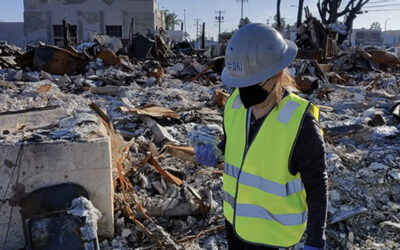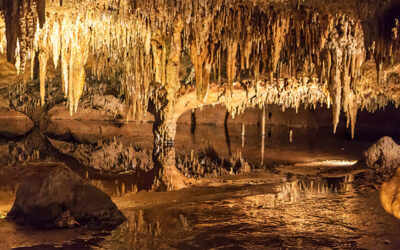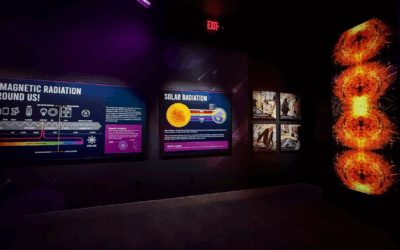Reno, Nev. (September 24, 2024) – DRI’s STEM Education Program has received a grant from the Department of Energy’s (DOE) Office of Environmental Management to support Nevada’s clean energy workforce pipeline. The nearly $2 million in funding will be used to prepare the next generation with the knowledge and technical skills needed for employment in fields such as clean energy, waste management, and environmental remediation.
“DRI is honored that the DOE recognizes the important work of our team in preparing Nevada’s students for the careers of the future,” said DRI STEM Education Training and Outreach Administrator Monica Gehrig, who is leading the project. “We are eager to build on our partnerships with the Atomic Museum and the NNSS while also incorporating tribal perspectives. This funding will allow us to introduce middle and high school students across the state to concepts that will directly benefit Nevada’s future environmental health.”
DRI’s STEM Education Program is partnering with the Nevada Test Site Historical Foundation at the Atomic Museum for this project, which will help provide students with the skills necessary for careers related to the Nevada National Security Site (NNSS). DRI scientists from the Community Environmental Monitoring Program and Cultural Resources Management Program will also partner with the STEM Education Program to create educational kits known as Green Boxes for middle and high school aged students. Over the three year project, the organizations will distribute the Green Boxes to schools throughout the state, and students will also take part in field trips to DRI and the Atomic Museum in Las Vegas for more immersive learning opportunities. Educator development trainings on the new curricula will be held and educators will also take part in field trips to the NNSS, with the support of DRI scientists. All of DRI’s Green Boxes are available to Nevada schools and educational programs free of charge, simply by request.
“This opportunity will open the Atomic Museum to thousands of underserved students within our community and drive the museum’s continued evolution,” said Atomic Museum Director of Education, Matthew Malinowski. “The museum will be designing new interactive exhibits and hands-on engagements to enhance career connections and create wonder and curiosity in science, technology, engineering, and math. We are privileged to work with our educational partners at DRI on this project to inspire the next generation of innovators.”
DRI has worked with the NNSS for several decades and teamed up with the Environmental Protection Agency (EPA) and DOE to establish the Community Environmental Monitoring Program (CEMP) in 1981. CEMP trains and partners with community members living in areas surrounding the NNSS to monitor airborne and groundwater environments for manmade radioactivity. The program is intended to foster transparency of NNSS activities.
DRI’s Cultural Resources Management Program (CRMP) works with the National Nuclear Security Administration Nevada Field Office and Environmental Management Nevada to identify and protect NNSS cultural resources. As part of this collaboration, DRI has assisted National Nuclear Security Administration Nevada Field Office and Environmental Management Nevada with running the NNSS American Indian Consultation Program since its inception in 1991. With the new funding, DRI’s STEM Education Program Team will work with the CRMP and DRI’s Tribal Liaison for the Fort McDermitt Paiute and Shoshone Tribe and Shoshone-Paiute Tribes to incorporate Indigenous perspectives and knowledge into the curriculum, field trip presentations, and professional development sessions. The project is expected to reach more than 38,000 Nevada students and 300 educators over three years.
– @driscience –
More information: For more information on DRI’s Green Boxes program, visit https://www-dev.dri.edu/stem-education-program/green-boxes
Read the DOE’s original release: https://www.energy.gov/em/articles/doe-announces-189-million-financial-assistance-grant-award-selections-12-disadvantaged
About DRI
We are Nevada’s non-profit research institute, founded in 1959 to empower experts to focus on science that matters. We work with communities across the state — and the world — to address their most pressing scientific questions. We’re proud that our scientists continuously produce solutions that better human and environmental health.
Scientists at DRI are encouraged to follow their research interests across the traditional boundaries of scientific fields, collaborating across DRI and with scientists worldwide. All faculty support their own research through grants, bringing in nearly $5 to the Nevada economy for every $1 of state funds received. With more than 600 scientists, engineers, students, and staff across our Reno and Las Vegas campuses, we conducted more than $47 million in sponsored research focused on improving peoples’ lives in 2023 alone.
At DRI, science isn’t merely academic — it’s the key to future-proofing our communities and building a better world. For more information, please visit www.dri.edu.
About The Atomic Museum
The Atomic Museum is operated and maintained by its parent company, the Nevada Test Site Historical Foundation (NTSHF), an IRS 501(c)3 charitable, non-profit organization chartered in Nevada. The Atomic Museum is one of more than 200 Smithsonian Affiliate organizations in nearly every state, plus Puerto Rico and Panama. Covering nuclear history beginning with the first test at the Nevada Test Site on January 27, 1951, the Atomic Museum’s exhibitions and programming also address current affairs related to the nuclear industry. For more information, go to atomicmuseum.vegas and follow on Facebook, Instagram, X (Twitter) and TikTok.
Media Contact
Elyse DeFranco
Lead Science Writer & Principal Information Officer, DRI
Elyse.DeFranco@www-dev.dri.edu


